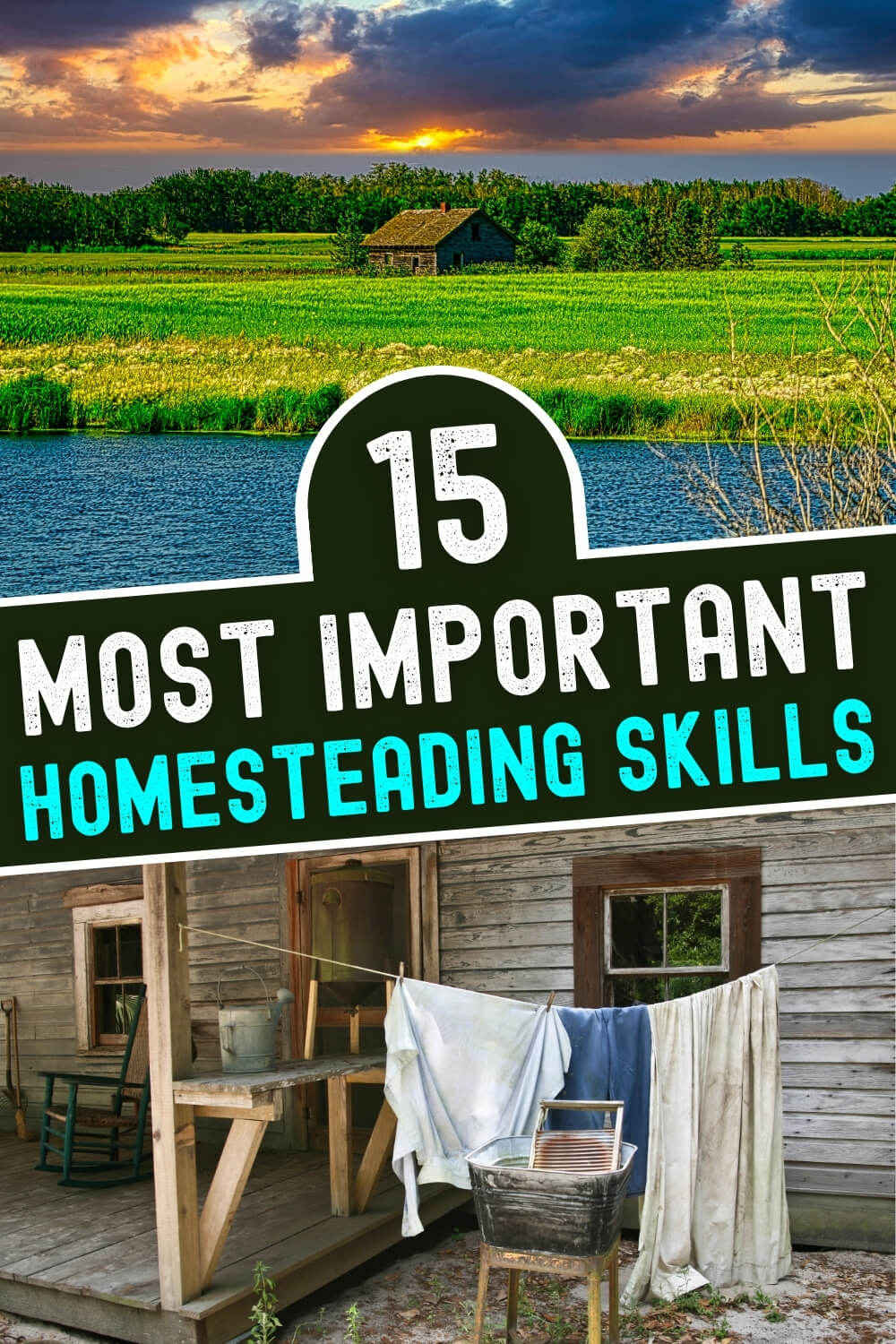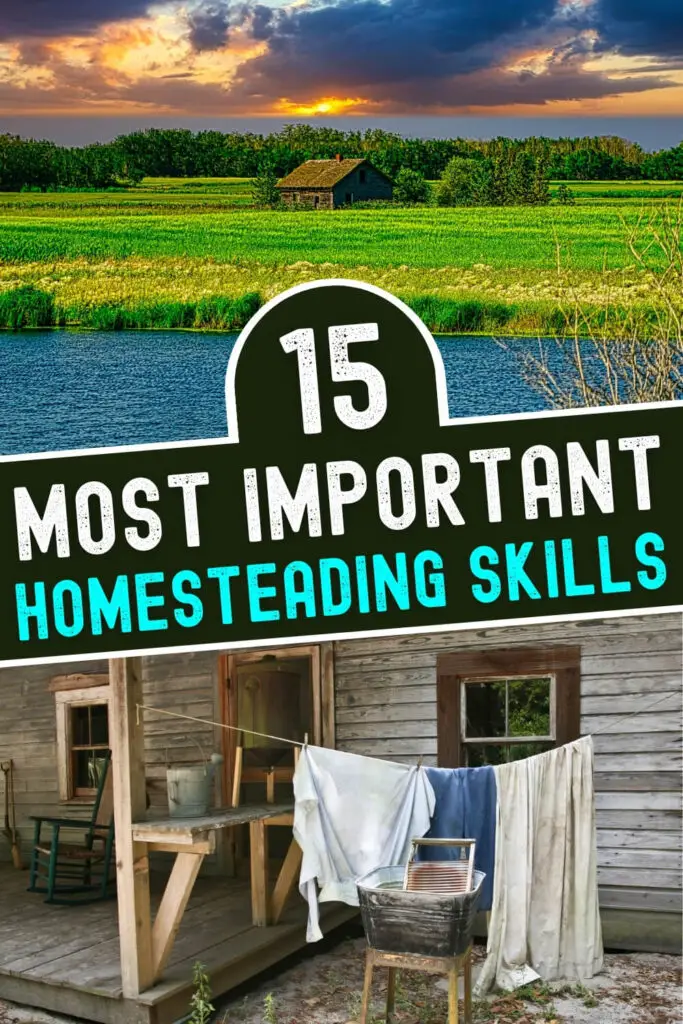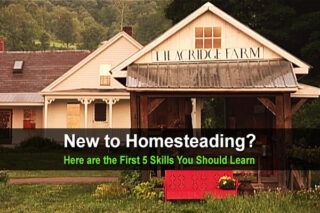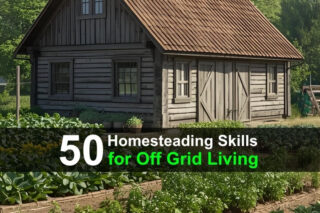Estimated reading time: 9 minutes
While being a proficient carpenter, owning a fleet of tractors, and mastering the art of welding are all fantastic skills on the homestead, none of them will make you a successful homesteader all by themselves. You’ve got to have an arsenal of information covering topics all across the board in order to maintain a sustainable life off the grid.
You don’t have to become a master gardener on the first try, but knowing the basics of planting and cultivating will certainly set you on the path to skills―and possibly passions―that will contribute to a marvelous garden down the line. Start small and let these skills grow.
Today, you’re going to do just that. Start small by taking 10 minutes out of your day to brush up on the most important homesteading skills and decide which one are you going to tackle first.
Want to save this post for later? Click Here to Pin It On Pinterest!
Animal Husbandry
For many, a totally self-sufficient homestead depends on the presence of animals. Horses to ride, chickens to lay eggs, dogs to guard, and pigs to eat―they all contribute to a symbiotic environment off the grid.
You can learn the “what” via some informational animal husbandry videos, “why” by listening to some thoughtful animal husbandry podcasts, and the “how” by signing up to an animal husbandry online course.
Composting
Any time you can reduce waste and repurpose products on the homestead is a big win. Composting conquers both of these goals.
A compost area is easy to set up, no matter if you’ve got a lot of land or are working with a small area.
You can go the super easy route and use a hefty trash bin as your compost area or build a semi-sophisticated compost area on your property using some flat palates or plywood like you’ll see here in this composting video.
Start your compost by using a mixture of grass clippings, straw, and other natural material. You can learn more here. Then when you have natural food waste to dispose of, toss it on top. Give it a good stir every couple of weeks. Here's a more detailed guide to making compost.
When everything is decomposed, you can use this compost soil as a fantastic fertilizer for your garden!
DIY Natural Remedies
When you’re miles away from a pharmacy and decades past doctors who do house calls, you’ve got to be prepared to step in as the on-site healer. Many homesteaders take pride in their ability to grow and concoct homeopathic remedies for minor to moderate conditions.
From herbs and spices in your cupboards to plants you can grow in your garden, study up on some ancient remedies to soothe and stifle any unwelcome ailments.
Fire Building
If a caveman can do it, so can you. As survivalists, building fire is in our blood! Once you get the hang of it, building and starting a fire will feel like second nature.
For the classic backyard bonfire, watch a couple YouTube videos on how to properly arrange your firewood. For emergency situations, you’ll want to know a couple fire-starting hacks like this one involving a cotton ball and Vaseline. Most importantly, equip yourself with a few tools such as a firesteel to help the process, and then practice! It’s always better to practice leisurely than in a desperate situation.
First Aid
We saved the most important skill for last! Always have a fully stocked first aid kit on hand! These kits take care of the everyday accidents like burns, cuts, and scrapes, and can also help prevent infections. Then begin stocking up on the big-ticket first aid items like medical accessories for sutures, military grade tourniquets, and anything else that will make the difference between life and death on the homestead.
Next, you need to learn how to apply your first aid supplies along with fundamental first aid skills such as CPR and the Heimlich maneuver.
Food Storage
You can go to the local grocery store right now and stock up on store-bought foods that have a long shelf life. These include flour, pasta, and canned goods. However, these goodies alone won’t provide you with a fully balanced diet. You need fruits, vegetables, and proteins that will provide essential vitamins and nutrients. For these, you’re going to need to learn how to can food.
First, you’ll need the proper canning supplies, and then you’ll need a whole lot of time. Canning is a full-day process that involves a lot of love and creativity, so make it fun! You’ll feel super accomplished once you step back and take a look at your fully stocked shelves full of long-lasting yummy goodness.
Fortifying Your Home Against Intruders
Zombies or robbers―they both know how to put a damper on a good night's sleep. There are some great ‘how-to’ security hacks out there that will give you and your family peace of mind.
Make sure you have the basics such as a home security alarm system to detect break-ins, waterproof surveillance systems that allow you to monitor large properties, and high-powered motion-sensing lights to start out.
Gardening
Are you planting the proper crops for your climate? Are you giving your root vegetables enough space to grow? Do you know how to spot and prevent plant diseases?
Before you plant every seed under the sun, take some time to get to know your crops and strategize what you’ll do with them. You can best utilize your space by planting in the ground, in window plants, in hanging pots, and in water. You can also use your plants to create an edible landscape that doubles as a fence, a wall, or the centerpiece of your yard.
Learn what plant grows best where and with which plant to pair the others by checking out (and printing) some plant growing charts.
How to Cook Without Electricity
The first time your power goes out on the homestead will be exciting! This is the moment you’ve been waiting for where you get to apply your newfound skills, including how to cook without electricity.
You’ve got a couple options that require simple prep and low-maintenance set up. You can go with the classic bonfire that creates warmth and a place to cook, the trusty gas stove with changeable propane tanks, or the super-delicious method with a charcoal grill. No one will go hungry on your watch.
How to Harvest and Salvage Seeds
Your plants and veggies can serve as a never-ending source of food once you know how to properly save seeds!
You can harvest seeds from cherry tomatoes, bell peppers, blueberries, and even carrots and use them to replant and harvest! Get a thin, sharp knife and a nice pair of pruning shears to make a day out of seed harvesting and storing!
Making Bread Off Grid
Is bread going to save your life by providing an ultra-significant nutritional component to your diet? No, probably not. But is a carb-tastic day going to boost your mood and strengthen the morale around camp? Absolutely! I mean, who doesn’t love bread?
Learn to grow your own yeast and bake your own bread on the homestead. It’s easier than you may think!
You’ll need an oven to get the job done. Using mud, sticks, and a little technique, you can build your own “Earthen Oven” in just a couple days. You can use this oven for anything bread or dough related, as well as casseroles and roasted veggies.
Natural Building Techniques
Embracing natural building techniques not only connects you more deeply with your environment but also allows for the creation of sustainable, energy-efficient homes and structures on your homestead. From cob and straw bale to timber framing and earthbag construction, explore various materials and methods that align with your climate and landscape.
Workshops and community builds are fantastic ways to gain practical experience. Building with natural materials reduces your reliance on industrial products, enhances your living space's thermal performance, and fosters a profound sense of achievement and connection to your homestead.
Solar Power Installation and Maintenance
Harnessing the power of the sun not only reduces your carbon footprint but also ensures your homestead remains operational even when the grid goes down. Start by familiarizing yourself with the components of a solar power system, including solar panels, batteries, inverters, and charge controllers.
Many resources are available to help you design a solar power system tailored to your energy needs. Consider taking a workshop or online course to gain hands-on experience. Remember, the initial investment in solar power pays dividends in energy independence and sustainability.
Tool Sharpening and Maintenance
A dull blade is more dangerous than a sharp one and far less effective. On the homestead, keeping your tools sharp and well-maintained is a skill that pays off daily. From kitchen knives and pruning shears to axes, hoes, and chainsaws, knowing how to sharpen, oil, and properly store your tools extends their life and improves your efficiency.
Learn to use a whetstone, file, or honing rod, and practice regularly. Build a habit of inspecting your tools after each use. It may seem small, but a well-maintained toolset is what separates a functioning homestead from a frustrating one.
Water Harvesting and Management
Water is the lifeblood of any homestead, crucial for drinking, irrigation, and supporting livestock. Begin by learning the basics of water harvesting techniques such as rainwater collection using barrels or designing a catchment system to capture and store rainwater from your roof.
Understanding how to purify and store water is equally important, ensuring you always have access to clean water while maintaining a sustainable homestead. Experiment with drip irrigation systems to efficiently water your garden, and explore the principles of greywater recycling to make the most of every drop.
Final Thoughts
As most of us know by now, the ultimate key to creating and maintaining a healthy and fulfilling off-the-grid lifestyle boils down to being prepared. Don’t skip steps, cut corners, or keep putting these skills off. Prepare your foundation now so that no matter what situation you face in the future, you’ll have enough information to help you out!
Your best way to prepare is to have a base knowledge in a variety of homestead skills across the board. For example, take one afternoon to study up on the essentials of potting plants and stocking your shed with essential tools. Now you have a solid foundation to grow your garden as you go.
Putting these skills on your homestead radar is step number one. Let your curiosity grow and some of these skills will inevitably become your passion projects. After all, homesteading isn’t just about living a disciplined life, it’s about living a well rounded, sustainable, and enjoyable life where you are in control of your environment.
Like this post? Don't Forget to Pin It On Pinterest!
You May Also Like:












